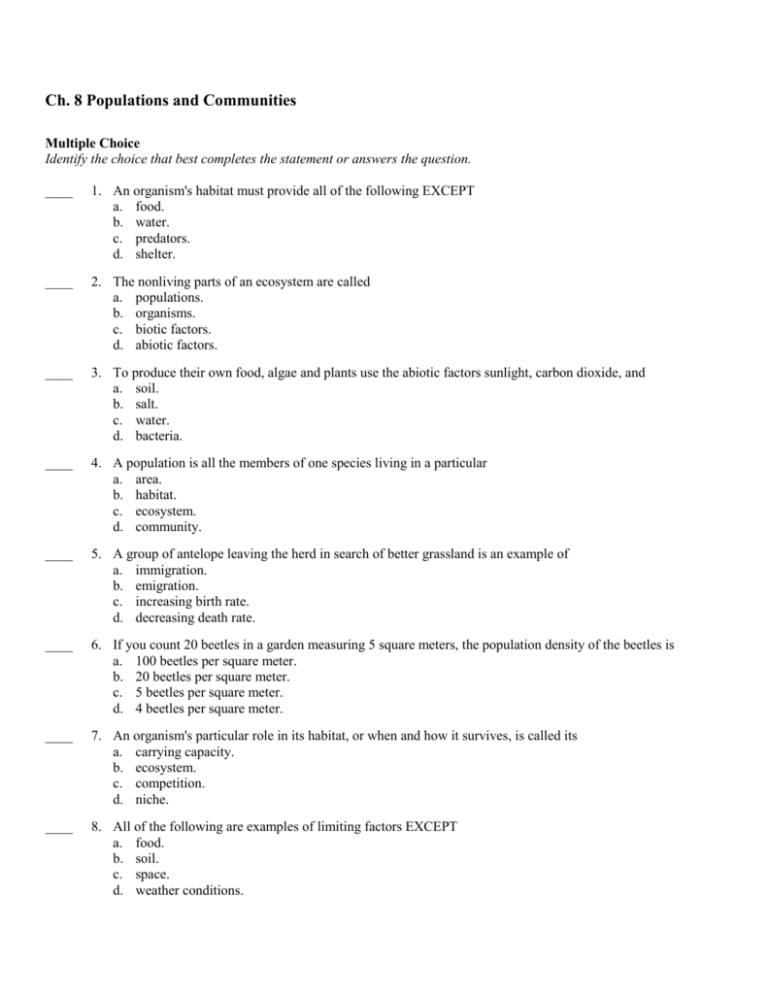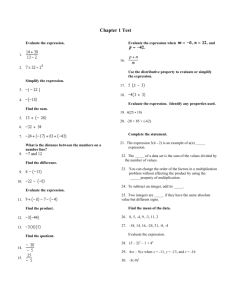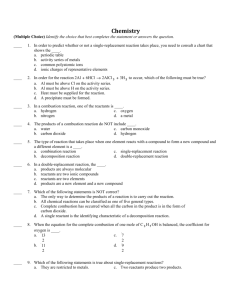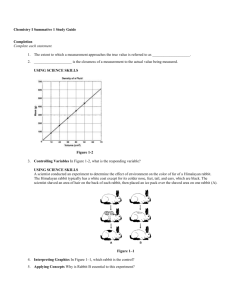Populations & Communities Test - Chapter 8
advertisement

Ch. 8 Populations and Communities Multiple Choice Identify the choice that best completes the statement or answers the question. ____ 1. An organism's habitat must provide all of the following EXCEPT a. food. b. water. c. predators. d. shelter. ____ 2. The nonliving parts of an ecosystem are called a. populations. b. organisms. c. biotic factors. d. abiotic factors. ____ 3. To produce their own food, algae and plants use the abiotic factors sunlight, carbon dioxide, and a. soil. b. salt. c. water. d. bacteria. ____ 4. A population is all the members of one species living in a particular a. area. b. habitat. c. ecosystem. d. community. ____ 5. A group of antelope leaving the herd in search of better grassland is an example of a. immigration. b. emigration. c. increasing birth rate. d. decreasing death rate. ____ 6. If you count 20 beetles in a garden measuring 5 square meters, the population density of the beetles is a. 100 beetles per square meter. b. 20 beetles per square meter. c. 5 beetles per square meter. d. 4 beetles per square meter. ____ 7. An organism's particular role in its habitat, or when and how it survives, is called its a. carrying capacity. b. ecosystem. c. competition. d. niche. ____ 8. All of the following are examples of limiting factors EXCEPT a. food. b. soil. c. space. d. weather conditions. ____ 9. Which of the following is an example of a predator adaptation? a. a porcupine's needles b. a shark's powerful jaws c. a frog's bright colors d. a plant's poisonous chemicals ____ 10. A hawk building its nest on an arm of a saguaro cactus is an example of a. commensalism. b. mutualism. c. parasitism. d. predation. ____ 11. The place where an organism lives and that provides the things the organism needs is called its a. habitat. b. population. c. species. d. community. ____ 12. Which of the following is a biotic factor in the prairie ecosystem? a. water b. sunlight c. soil d. grass ____ 13. The behaviors and physical characteristics of species that allow them to live successfully in their environment are called a. habitats. b. limiting factors. c. biotic factors. d. adaptations. ____ 14. The struggle between organisms to survive in a habitat with limited resources is called a. competition. b. predation. c. symbiosis. d. parasitism. ____ 15. The series of changes that occurs after a disturbance in an existing ecosystem is called a. primary succession. b. secondary succession. c. disturbance succession. d. pioneer succession. ____ 16. The first species to populate an area where primary succession is taking place are called a. secondary species. b. primary species. c. pioneer species. d. succession species. ____ 17. Population density is defined as a. an approximation of a number, based on reasonable assumptions. b. the number of individuals of a population in a specific area. c. the number of individuals moving into a population. d. the smallest level of ecological organization. ____ 18. The largest population that an environment can support is called its a. carrying capacity. b. limiting factor. c. birth rate. d. death rate. ____ 19. An early winter frost preventing further growth in a tomato garden is an example of a. carrying capacity. b. a limiting factor. c. a biotic factor. d. indirect observation. ____ 20. The smallest unit of ecological organization is a single a. population. b. community. c. organism. d. ecosystem. ____ 21. Which of the following is an example of a population? a. the cats and dogs in your neighborhood b. the bushes and grass in a park c. the rocks in a rock collection d. the gray wolves in a forest ____ 22. All the different populations that live together in an area make up a(n) a. organism. b. community. c. species. d. ecosystem. ____ 23. The study of how things interact with each other and with their environment is called a. ecology. b. photosynthesis. c. community. d. biotic studies. ____ 24. When a flea is living on a dog, the dog is the a. parasite. b. host. c. predator. d. prey. ____ 25. Mutualism, commensalism, and parasitism are the three types of a. symbiotic relationships. b. predation. c. competition. d. prey adaptations. Ch. 8 Populations and Communities Answer Section MULTIPLE CHOICE 1. ANS: OBJ: BLM: 2. ANS: OBJ: BLM: 3. ANS: OBJ: BLM: 4. ANS: OBJ: BLM: 5. ANS: OBJ: BLM: 6. ANS: OBJ: BLM: 7. ANS: OBJ: BLM: 8. ANS: OBJ: BLM: 9. ANS: OBJ: BLM: 10. ANS: OBJ: BLM: 11. ANS: OBJ: BLM: 12. ANS: OBJ: BLM: 13. ANS: OBJ: BLM: 14. ANS: OBJ: BLM: 15. ANS: C PTS: 1 DIF: L2 Identify what an organism gets from its environment. comprehension D PTS: 1 DIF: L1 Identify biotic and abiotic parts of a habitat. knowledge C PTS: 1 DIF: L2 Identify biotic and abiotic parts of a habitat. comprehension A PTS: 1 DIF: L1 Describe the levels of organization within an ecosystem. knowledge B PTS: 1 DIF: L2 Explain the causes of changes in population size. application D PTS: 1 DIF: L3 Explain the causes of changes in population size. application D PTS: 1 DIF: L1 Explain how an organism's adaptations help it survive. knowledge B PTS: 1 DIF: L2 Identify factors that limit population growth. comprehension B PTS: 1 DIF: L2 Describe the competition and predation. application A PTS: 1 DIF: L2 Identify the three types of symbiotic relationships. application A PTS: 1 DIF: L1 Identify what an organism gets from its environment. knowledge D PTS: 1 DIF: L2 Identify biotic and abiotic parts of a habitat. comprehension D PTS: 1 DIF: L1 Explain how an organism's adaptations help it survive. knowledge A PTS: 1 DIF: L1 Describe the competition and predation. knowledge B PTS: 1 DIF: L1 TOP: e_ch01_018 TOP: e_ch01_019 TOP: e_ch01_020 TOP: PH_EN_SC_MGS_2010_X_55873 TOP: e_ch01_007 TOP: e_ch01_005 TOP: e_ch01_010 TOP: e_ch01_017 TOP: e_ch01_022 TOP: e_ch01_028 TOP: e_ch01_002 TOP: e_ch01_001 TOP: e_ch01_011 TOP: e_ch01_012 16. 17. 18. 19. 20. 21. 22. 23. 24. 25. OBJ: TOP: ANS: OBJ: TOP: ANS: OBJ: BLM: ANS: OBJ: BLM: ANS: OBJ: BLM: ANS: OBJ: BLM: ANS: OBJ: BLM: ANS: OBJ: BLM: ANS: OBJ: BLM: ANS: OBJ: BLM: ANS: OBJ: BLM: Describe the differences between primary and secondary succession. e_ch01_029 BLM: knowledge C PTS: 1 DIF: L2 Describe the differences between primary and secondary succession. e_ch01_030 BLM: comprehension B PTS: 1 DIF: L1 Explain the causes of changes in population size. TOP: e_ch01_027 knowledge A PTS: 1 DIF: L1 Identify factors that limit population growth. TOP: e_ch01_009 knowledge B PTS: 1 DIF: L2 Identify factors that limit population growth. TOP: e_ch01_016 application C PTS: 1 DIF: L1 Describe the levels of organization within an ecosystem. TOP: e_ch01_003 knowledge D PTS: 1 DIF: L2 Describe the levels of organization within an ecosystem. TOP: e_ch01_004 application B PTS: 1 DIF: L1 Describe the levels of organization within an ecosystem. TOP: e_ch01_023 knowledge A PTS: 1 DIF: L1 Describe the levels of organization within an ecosystem. TOP: e_ch01_024 knowledge B PTS: 1 DIF: L2 Identify the three types of symbiotic relationships. TOP: e_ch01_025 application A PTS: 1 DIF: L1 Identify the three types of symbiotic relationships. TOP: e_ch01_026 knowledge









